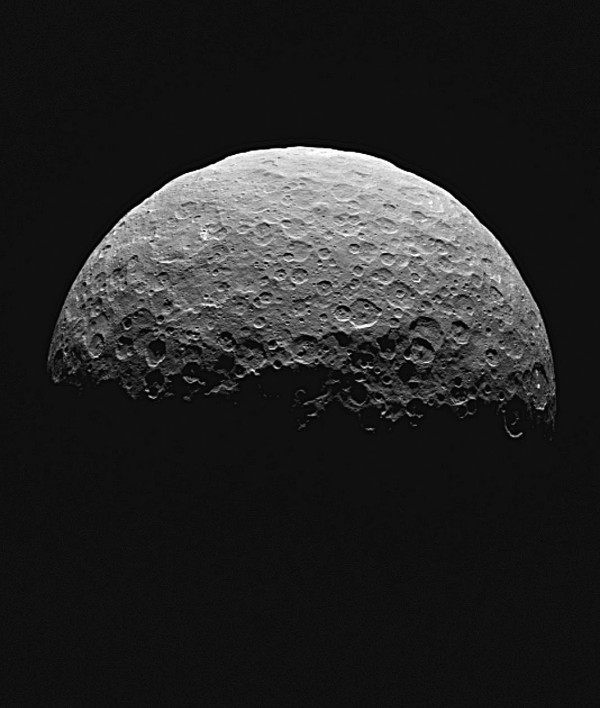NASA Reveals New Video of Mysterious Bright Spots on Dwarf Planet Ceres
| Ana Verayo | | Apr 21, 2015 09:03 AM EDT |
(Photo : NASA/JPL-Caltech/UCLA/MPS/DLR/IDA) Dawn took this image on April 14 and 15 from a vantage point 14,000 miles (22,000 kilometers) above Ceres' northern hemisphere.
NASA's Dawn spacecraft has now officially begun its science mission as it orbits the mysterious, dwarf planet Ceres. New images from the spacecraft again show those intriguing bright spots glowing on the planet's surface.
Dawn arrived at Ceres on March 6 and captured the eerie bright spots on April 14 and 15 as part of a photography campaign specifically designed to guide the spacecraft during its first orbit on April 23.
Like Us on Facebook
NASA officials combined the photos and released a short video that presents Ceres' bright spots moving as the tiny world rotates.
The spacecraft's approach combined with an imaging campaign has been a success in providing an unprecedented view of Ceres, which Dawn will further explore in more detail, according to Dawn Mission Director and Chief Engineer Marc Rayman from NASA's Jet Propulsion Laboratory. This new information has allowed the team to ask more new and intriguing questions, he adds.
These new photos were taken by Dawn from a distance of 14,000 miles above the north pole of Ceres. To date, the bright white spots are still an enigma to NASA scientists even if they suggest they could be ice or salt deposits.
These bright spots are just one of many scientific mysteries Dawn will unravel with intensive observations on April 23. Initial observations will be conducted from a circular orbit of 8,400 miles from the dwarf planet.
On May 9, the probe will slowly spiral down to get a closer look and obtain better views of Ceres, which is the largest body in the asteroid belt between Mars and Jupiter. Ceres measures 590 miles wide.
Launched in September 2007, the mission of the US$466 million spacecraft is to further observe the dwarf planet along with Vesta, which is the second largest body in the asteroid belt.
Scientists consider the two objects as intact protoplanets, which are remnants from the formation of the solar system. Learning more about their composition and terrain could provide pivotal clues and insights about how rocky planets like Earth are formed.
Dawn explored Vesta from July 2011 to September 2012. The probe is scheduled to observe and explore Ceres until June 2016 when it will run out of fuel. It is also the only spacecraft to orbit two different bodies located beyond the Earth-Moon system and the first to study a dwarf planet up close.
TagsNASA, NASA Dawn, dwarf planet Ceres, bright spots ceres dwarf planet dawn, photos bright spots ceres dwarf planet, video bright spots dwarf planet ceres, dawn ceres bright spots
©2015 Chinatopix All rights reserved. Do not reproduce without permission
EDITOR'S PICKS
-

Did the Trump administration just announce plans for a trade war with ‘hostile’ China and Russia?
-

US Senate passes Taiwan travel bill slammed by China
-

As Yan Sihong’s family grieves, here are other Chinese students who went missing abroad. Some have never been found
-

Beijing blasts Western critics who ‘smear China’ with the term sharp power
-

China Envoy Seeks to Defuse Tensions With U.S. as a Trade War Brews
-

Singapore's Deputy PM Provides Bitcoin Vote of Confidence Amid China's Blanket Bans
-

China warns investors over risks in overseas virtual currency trading
-

Chinese government most trustworthy: survey
-

Kashima Antlers On Course For Back-To-Back Titles
MOST POPULAR
LATEST NEWS
Zhou Yongkang: China's Former Security Chief Sentenced to Life in Prison

China's former Chief of the Ministry of Public Security, Zhou Yongkang, has been given a life sentence after he was found guilty of abusing his office, bribery and deliberately ... Full Article
TRENDING STORY

China Pork Prices Expected to Stabilize As The Supplies Recover

Elephone P9000 Smartphone is now on Sale on Amazon India

There's a Big Chance Cliffhangers Won't Still Be Resolved When Grey's Anatomy Season 13 Returns

Supreme Court Ruled on Samsung vs Apple Dispute for Patent Infringement

Microsoft Surface Pro 5 Rumors and Release Date: What is the Latest?










